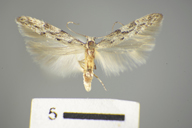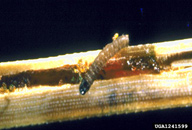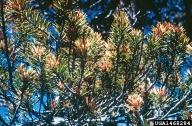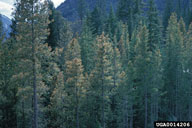Lodgepole needleminer
Coleotechnites milleri (Busck) (Lepidoptera: Gelechiidae)
Orientation to pest
Lodgepole needleminer, Coleotechnites milleri (Busck), is a native North American gelechiid moth whose larvae mine needles of lodgepole pine (Pinus contorta Douglas ex Loud.). Larvae of all ages mine needles. Sustained and repeated outbreaks of this species have occurred in Yosemite National Park in California, causing widespread tree mortality. The adults are active from mid-July to mid-August in odd numbered years (each generation requires two years). Eggs are laid in late summer and hatch the same year. First instars mine a single needle, near the growing tip, and overwinter inside the minded needle. The following year, larvae feed on several needles (as needle miners) and develop to the fourth instar by the end of their second growing season. Fourth instars overwinter in mined needles and in the third year, fifth instars complete their feeding inspring, pupate in mined needles, and emerge as adults by mid-summer.
Hosts commonly attacked
The only known host is lodgepole pine (P. contorta).
Distribution
This insect is found in the western North American (USA and Canada) within the range of lodgepole pine.
Images of lodgepole needleminer
| Figure 1. Adult of lodgepole needleminer, Coleotechnites milleri | Figure 2. Larva of lodgepole needleminer | Figure 3. Damage from lodgepole needleminer | Figure 4. Stand of lodgepole pine damaged by lodgepole needleminer |
Important biological control agents related to this pest species
Many parasitoids and other natural enemies attacked this species during the declining phase of an outbreak in California (Struble, 1967). Collectively the larval and pupal parasitoids caused 28-46% mortality.
Articles
- Struble, G. R. 1967. Insect enemies in the natural control of the lodgepole needle miner. Journal of Economic Entomology 60: 225-228.
- Struble, G. R. 1973. Biology, ecology, and control of the lodgepole needle miner. Technical Bulletin, U.S. Department of Agriculture No. 1458, 38 pp.







